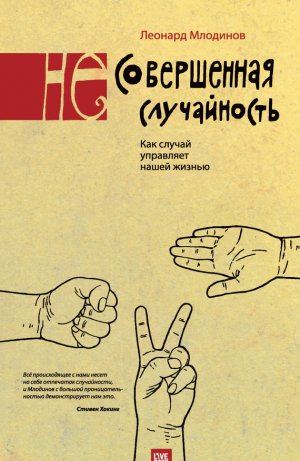(Не)совершенная случайность. Как случай управляет нашей жизнью Млодинов Леонард

Thomas R. Gilovich, Robert Vallone, and Amos Tversky, «The Hot Hand in Basketball: On the Misperception of Random Sequences», Cognitive Psychology 17, no. 3 (July 1985): 295–314.
209
Purcell's research is discussed in Gould, «The Streak of Streaks.»
210
Mark Hulbert, «Not All Stocks Are Created Equal», www.MarketWatch.com, January 18, 2005, accessed March 2005 (site now discontinued).
211
Kunal Kapoor, «A Look at Who's Chasing Bill Miller's Streak», Morningstar, December 30, 2004, http://www.morningstar.com.
212
Michael Mauboussin and Kristen Bartholdson, «On Streaks: Perception, Probability, and Skill», Consilient Observer (Credit Suisse-First Boston) 2, no. 8 (April 22, 2003).
213
Merton Miller on «Trillion Dollar Bet», NOVA, PBS broadcast, February 8, 2000.
214
R.D. Clarke, «An Application of the Poisson Distribution», Journal of the Institute of Actuaries 72 (1946): 48
215
Atul Gawande, «The Cancer Cluster Myth», The New Yorker, February 28,1998, pp. 34–37.
216
Ibid.
217
Bruno Bettelheim, «Individual and Mass Behavior in Extreme Situations», Journal of Abnormal and Social Psychology 38 (1943): 417-52.
218
Curt P. Richter, «On the Phenomenon of Sudden Death in Animals and Man», Psychosomatic Medicine 19 (1957): 191-98.
219
E. Stotland and A. Blumenthal, «The Reduction of Anxiety as a Result of the Expectation of Making a Choice», Canadian Review of Psychology 18 (1964): 139-45.
220
Ellen Langer and Judith Rodin, «The Effects of Choice and Enhanced Personal Responsibility for the Aged: A Field Experiment in an Institutional Setting», Journal of Personality and Social Psychology 34, no. 2 (1976): 191-98.
221
Ellen Langer and Judith Rodin, «Long-Term Effects of a Control-Relevant Intervention with the Institutionalized Aged», Journal of Personality and Social Psychology 35, no. 12 (1977): 897–902.
222
L. B. Alloy and L. Y. Abramson, «Judgment of Contingency in Depressed and Nondepressed Students: Sadder but Wiser?» Journal of Experimental Psychology: General 108, no. 4 (December 1979): 441-85.
223
Durgin, «The Tinkerbell Effect.»
224
Ellen Langer, «The Illusion of Control», Journal of Personality and Social Psychology 32, no. 2 (1975): 311-28.
225
Ellen Langer and Jane Roth, «Heads I Win, Tails It's Chance: The Illusion of Control as a Function of Outcomes in a Purely Chance Task», Journal of Personality and Social Psychology 32, no. 6 (1975): 951-55.
226
Langer, «The Illusion of Control.»
227
Ibid., p. 311.
228
Raymond Fisman, Rakesh Khurana, and Matthew Rhodes-Kropf, «Governance and CEO Turnover: Do Something or Do the Right Thing?» (working paper no. 05-066, Harvard Business School, Cambridge, Mass., April 2005).
229
P.C. Wason, «Reasoning about a Rule», Quarterly Journal of Experimental Psychology 20 (1968): 273-81.
230
Francis Bacon, Novum Organon, trans, by P. Urbach and J. Gibson (Chicago: Open Court, 1994), p. 57 (originally published in 1620).
231
Charles G. Lord, Lee Ross, and Mark Lepper, «Biased Assimilation and Attitude Polarization: The Effects of Prior Theories on Subsequently Considered Evidence», Journal of Personality and Social Psychology 37, no. 11 (1979): 2098-109.
232
Matthew Rabin, «Psychology and Economics» (white paper, University of California, Berkeley, September 28, 1996).
233
E. C. Webster, Decision Making in the Employment Interview (Montreal: Industrial Relations Centre, McGill University, 1964).
234
Beth E. Haverkamp, «Confirmatory Bias in Hypothesis Testing for Client-Identified and Counselor Self-generated Hypotheses», Journal of Counseling Psychology 40, no. 3 (July 1993): 303-15.
235
David L. Hamilton and Terrence L. Rose, «Illusory Correlation and the Maintenance of Stereotypic Beliefs», Journal of Personality and Social Psychology 39, no. 5 (1980): 832-45; Galen V. Bodenhausen and Roberts. Wyer, «Effects of Stereotypes on Decision Making and Information-Processing Strategies», Journal of Personality and Social Psychology 48, no. 2 (1985): 267-82; and C. Stangorand D. N. Ruble, «Strength of Expectancies and Memory for Social Information: What We Remember Depends on How Much We Know», Journal of Experimental Social Psychology 25, no. 1 (1989): 18–35.
236
Pierre-Simon de Laplace, quoted in Stigler, Statistics on the Table, p. 56.
237
James Gleick, Chaos: Making a New Science (New York: Penguin, 1987); see chap. 1.
238
Max Born, Natural Philosophy of Cause and Chance (Oxford: Clarendon Press, 1948), p. 47. Борн имел в виду природу в общем и квантовую теорию в частности
239
The Pearl Harbor analysis is from Roberta Wohlstetter, Pearl Harbor: Warning and Decision (Palo Alto, Calif.: Stanford University Press, 1962).
240
Richard Henry Tawney, The Agrarian Problem in the Sixteenth Century (1912; repr., New York: Burt Franklin, 1961).
241
Wohlstetter, Pearl Harbor, p. 387.
242
The description of the events at Three Mile Island is from Charles Perrow, Normal Accidents: Living with High-Risk Technologies (Princeton, N.J.: Princeton University Press, 1999); and U.S. Nuclear Regulatory Commission, «Fact Sheet on the Three Mile Island Accident»,
http://www.nrc.gov/reading-rm/doc-collections/fact-sheets/3mile-isle.html.
243
Perrow, Normal Accidents.
244
W. Brian Arthur, «Positive Feedbacks in the Economy», Scientific American, February 1990, pp. 92–99.
245
Matthew J. Salganik, Peter Sheridan Dodds, and Duncan J. Watts, «Experimental Study of Inequality and Unpredictability in an Artificial Cultural Market», Science 311 (February 10, 2006); and Duncan J. Watts, «Is Justin Timberlake a Product of Cumulative Advantage?» New York Times Magazine, April 15, 2007.
246
Mlodinow, «Meet Hollywood's Latest Genius.»
247
John Steele Gordon and Michael Maiello, «Pioneers Die Broke», Forbes, December 23, 2002; and «The Man Who Could Have Been Bill Gates», Business-Week, October 25, 2004.
248
Floyd Norris, «Trump Deal Fails, and Shares Fall Again», New York Times,]uly 6, 2007.
249
Melvin J. Lerner and Leo Montada, «An Overview: Advances in Belief in a Just World Theory and Methods», in Responses to Victimizations and Belief in a Just World, ed. Leo Montada and Melvin J. Lerner (New York: Plenum Press, 1998), pp. 1–7.
250
Melvin J. Lerner, «Evaluation of Performance as a Function of Performer's Reward and Attractiveness», Journal of Personality and Social Psychology 1 (1965): 355-60.
251
Melvin J. Lerner and С. H. Simmons, «Observer's Reactions to the 'Innocent Victim': Compassion or Rejection?» Journal of Personality and Social Psychology 4 (1966): 203-10.
252
Lerner, «Evaluation of Performance as a Function of Performer's Reward and Attractiveness.»
253
Wendy Jean Harrod, «Expectations from Unequal Rewards», Social Psychology Quarterly 43, no. 1 (March 1980): 126-30; Penni A. Stewart and James C. Moore Jr., «Wage Disparities and Performance Expectations», Social Psychology Quarterly 55, no. 1 (March 1992): 78–85; and Karen S. Cook, «Expectations, Evaluations and Equity», American Sociological Review 40, no. 3 (June 1975): 372-88.
254
Lerner and Simmons, «Observer's Reactions to the 'Innocent Victim'».
255
David L. Rosenhan, «On Being Sane in Insane Places», Science 179 (January 19, 1973): 237-55.
256
Elisha Y. Babad, «Some Correlates of Teachers' Expectancy Bias», American Educational Research Journal 22, no. 2 (Summer 1985): 175-83.
257
Eric Asimov, «Spirits of the Times: A Humble Old Label Ices Its Rivals», New York Times, January 26, 2005.
258
Jonathan Calvert and Will Iredale, «Publishers Toss Booker Winners into the Reject Pile», London Sunday Times, January 1, 2006.
259
Peter Doskoch, «The Winning Edge», Psychology Today, November/ December 2005, p. 44.
260
Rosenhan, «On Being Sane in Insane Places», p. 243.






